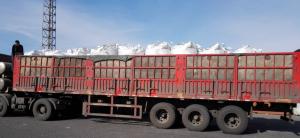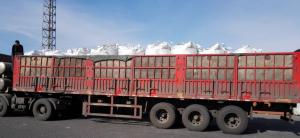CPC Powder High FC Carbon Low Sulfur Low Ash
- Loading Port:
- Tianjin
- Payment Terms:
- TT or LC
- Min Order Qty:
- 20 m.t.
- Supply Capability:
- 1500 m.t./month
OKorder Service Pledge
OKorder Financial Service
You Might Also Like
Packaging & Delivery
| Packaging Detail: | 50kg/bag 100kg/bag 1000kg/bag Or according with client need to do |
| Delivery Detail: | 2 weeks |
Specifications
CPC Powder High FC Carbon Low Sulfur Low Ash
Petroleum coke products can be divided into needle coke, sponge coke, projectile coke and coke breeze four kinds.
Calcined Petroleum Coke
F.C.: 98.5%MIN
ASH: 0.8% MAX
V.M.: 0.7%MAX
S:0.5%MAX
Moisture: 0.5%MAX
Structure
CPC Powder High FC Carbon Low Sulfur Low Ash
Shape: granule
· Dimensions: 0-1mm, 1-5mm, 1-6mm, 2-8mm, etc
· Product Type: Carbon Additive
· C Content (%): 98-99.5% MIN
· Working Temperature: -
· S Content (%): 0.5%-0.7%MAX
· Ash Content (%): 0.7%MAX
· Volatile:0.8%MAX
· Moisture: 0.5% MAX
· ADVANTAGE: low ash & sulfur
· COLOR: Black
Feature
CPC Powder High FC Carbon Low Sulfur Low Ash
Physics and chemistry performance:
Unit | Index | |||||
No.1 | No.2 | No.3 | ||||
Density | g/cm3 | 2.04 | 2.00 | 2.00 | ||
sulphur content | %≤ | 0.5 | 1.0 | 2.5 | ||
volatility | %≤ | 0.5 | 0.5 | 0.5 | ||
ash content | %≤ | 0.5 | 0.5 | 0.5 | ||
moisture | %≤ | 0.3 | 0.5 | 0.5 | ||
charcoal | %≤ | 98.5 | 98.0 | 98.0 | ||
Image
CPC Powder High FC Carbon Low Sulfur Low Ash
FAQ:
CPC Powder High FC Carbon Low Sulfur Low Ash
How to classify calcined petroleum coke?
1) According to difference of sulfur content, can be divided into high sulfur coke (sulfur content more than 4%), sulphur in coke sulfur content (2% 4%) and low sulfur coke (sulfur content below 2%).
2) Petroleum coke products can be divided into needle coke, sponge coke, projectile coke and coke breeze four kinds:
3) Needle coke, has obvious needle-like structure and fiber texture, mainly used for steel-making in high power and ultra-high power graphite electrode. As a result of needle coke in sulfur content, ash content, volatile matter and true density and so on have strict quality requirements, so the production process of needle coke and raw materials have special requirements.
4) The sponge coke, high chemical reactivity, low content of impurities, mainly used in the aluminum industry and carbon industry.
5) Focal or spherical coke: the projectile shape is round, diameter 0.6-30 mm, usually from the production of high sulphur, high asphaltic residual oil, can only be used as industrial fuel power generation, cement etc.
6) Coke breeze: fluidized coking process, the fine particles (0.1- 0.4 mm) in diameter, high volatile, high expansion coefficient, cannot be directly used for electrode preparation and carbon industry.
Advantage:
CPC Powder High FC Carbon Low Sulfur Low Ash
1. High quality and competitive price.
2. Timely delivery.
3. If any item you like. Please contact us.
Your sincere inquiries are typically answered within 24 hours.
- Q:What is the relationship between carbon and climate change?
- The relationship between carbon and climate change is that carbon dioxide (CO2), primarily emitted through human activities such as burning fossil fuels, is a greenhouse gas that contributes to the warming of the Earth's atmosphere. The excessive release of CO2 traps heat, leading to a rise in global temperatures and subsequent climate change impacts such as melting ice caps, rising sea levels, extreme weather events, and disruptions to ecosystems.
- Q:What is the structure of a diamond, a form of carbon?
- A diamond, which is a form of carbon, has a crystal lattice structure. In this arrangement, each carbon atom is covalently bonded to four other carbon atoms, forming a tetrahedral arrangement. This creates a repeating pattern and a three-dimensional network of carbon atoms. The bonds between the carbon atoms are incredibly strong, which is why diamonds are so hard and durable. The carbon atoms in a diamond are arranged in a cubic crystal system, specifically the face-centered cubic (FCC) structure. In this system, each carbon atom is surrounded by eight neighboring carbon atoms, resulting in a dense and tightly packed structure. The strong covalent bonds and compact arrangement of carbon atoms in the diamond lattice give diamonds their unique properties. These properties include exceptional hardness, high thermal conductivity, and optical brilliance.
- Q:How does carbon impact the availability of natural resources?
- Carbon impacts the availability of natural resources by contributing to climate change. Excessive carbon emissions, primarily from burning fossil fuels, lead to global warming, which in turn affects the availability and distribution of resources such as water, food, and energy. Additionally, carbon pollution can cause ocean acidification, harming marine ecosystems and reducing fish populations. Therefore, controlling carbon emissions is crucial to ensure the sustainable availability of natural resources.
- Q:How does carbon dioxide affect textile production?
- Carbon dioxide affects textile production in several ways. Firstly, the production of synthetic fibers such as polyester and nylon, which are widely used in the textile industry, involves the emission of carbon dioxide during the manufacturing process. This contributes to greenhouse gas emissions and climate change. Additionally, carbon dioxide is released during the combustion of fossil fuels used for energy in textile factories. This not only adds to the environmental impact but also affects air quality and human health. Moreover, the dyeing and finishing processes in textile production often require the use of chemicals that emit carbon dioxide when they break down or react with other substances. These emissions further contribute to the carbon footprint of the industry. Overall, carbon dioxide has a significant impact on textile production, primarily through the emissions generated during fiber manufacturing, energy consumption, and chemical usage. Therefore, efforts to reduce carbon dioxide emissions and transition to more sustainable practices are crucial for mitigating the environmental impact of the textile industry.
- Q:How does carbon impact the availability of sustainable agriculture practices?
- Carbon impacts the availability of sustainable agriculture practices in several ways. Firstly, carbon emissions from various human activities, such as burning fossil fuels and deforestation, contribute to climate change. This change in climate patterns can lead to extreme weather events like droughts, floods, and heatwaves, which can negatively affect agricultural productivity. Furthermore, excessive carbon in the atmosphere contributes to the greenhouse effect, trapping heat and raising global temperatures. This rise in temperature can disrupt natural ecosystems and reduce the availability of arable land for agriculture. It can also alter precipitation patterns, leading to water scarcity or excessive rainfall, both of which can hinder sustainable agriculture practices. Carbon also plays a role in soil health and fertility. Excessive carbon dioxide in the atmosphere can be absorbed by soils, leading to increased soil acidity. This acidification can lower soil pH levels, making it difficult for crops to absorb essential nutrients. Additionally, high carbon levels can impact soil microorganisms, which are crucial for nutrient cycling and maintaining soil fertility. However, carbon can also have positive impacts on sustainable agriculture practices. Carbon sequestration, the process of capturing and storing carbon dioxide from the atmosphere, can be utilized to enhance soil health. Practices like planting cover crops, adopting agroforestry systems, and implementing no-till farming techniques can help sequester carbon in the soil, improving its fertility and resilience. This, in turn, promotes sustainable agriculture by increasing crop yields, reducing the need for synthetic fertilizers, and enhancing soil water-holding capacity. In conclusion, carbon emissions and their effects on climate change and soil health significantly impact the availability of sustainable agriculture practices. Mitigating carbon emissions and adopting practices that sequester carbon are crucial for ensuring a sustainable and resilient agricultural system in the face of climate change.
- Q:How to test aldehyde group and carbon carbon double bond in acrolein
- Can be oxidized into carboxyl aldehyde with silver ammonia solution or new copper hydroxide,
- Q:What role does carbon play in photosynthesis?
- Carbon plays a crucial role in photosynthesis as it is the primary element used by plants to produce organic compounds. During photosynthesis, plants absorb carbon dioxide from the atmosphere and use it to synthesize glucose, a simple sugar that serves as a building block for more complex carbohydrates, such as starch and cellulose. This process occurs in the chloroplasts of plant cells, specifically in the stroma of the chloroplast, where the enzyme RuBisCO catalyzes the fixation of carbon dioxide into an organic molecule called PGA (phosphoglycerate). Through a series of reactions known as the Calvin cycle, PGA is converted into glucose, which can be stored for energy or used for growth and reproduction. In summary, carbon is essential for photosynthesis as it provides the raw material necessary for plants to produce their own food and sustain life.
- Q:What are greenhouse gases?
- Greenhouse gases are gases that trap heat in the Earth's atmosphere, contributing to the greenhouse effect. They include carbon dioxide (CO2), methane (CH4), nitrous oxide (N2O), and fluorinated gases. These gases are naturally occurring and are also emitted through human activities such as burning fossil fuels, deforestation, and industrial processes. The greenhouse effect is vital for life on Earth as it helps to keep the planet warm enough to support life. However, excessive emissions of greenhouse gases have caused an imbalance in the atmosphere, leading to global warming and climate change. It is important to reduce greenhouse gas emissions and find sustainable alternatives to mitigate the impacts of these gases on our planet.
- Q:How does carbon affect the formation of acid rain?
- Carbon does not directly affect the formation of acid rain. Acid rain is primarily caused by emissions of sulfur dioxide and nitrogen oxides, which react with water, oxygen, and other chemicals in the atmosphere to form sulfuric acid and nitric acid. However, carbon dioxide, a greenhouse gas emitted from the burning of fossil fuels, contributes to climate change. Climate change can alter weather patterns and increase the frequency and intensity of precipitation, which can indirectly affect the acidity of rain.
1. Manufacturer Overview |
|
|---|---|
| Location | |
| Year Established | |
| Annual Output Value | |
| Main Markets | |
| Company Certifications | |
2. Manufacturer Certificates |
|
|---|---|
| a) Certification Name | |
| Range | |
| Reference | |
| Validity Period | |
3. Manufacturer Capability |
|
|---|---|
| a)Trade Capacity | |
| Nearest Port | |
| Export Percentage | |
| No.of Employees in Trade Department | |
| Language Spoken: | |
| b)Factory Information | |
| Factory Size: | |
| No. of Production Lines | |
| Contract Manufacturing | |
| Product Price Range | |
Send your message to us
CPC Powder High FC Carbon Low Sulfur Low Ash
- Loading Port:
- Tianjin
- Payment Terms:
- TT or LC
- Min Order Qty:
- 20 m.t.
- Supply Capability:
- 1500 m.t./month
OKorder Service Pledge
OKorder Financial Service
Similar products
New products
Hot products






























